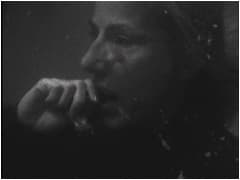The Drowning Room
“A sequence of domestic vignettes from the sunken suburbs. In the house, the stagnant atmosphere has slowly thickened to liquid. The inhabitants try to carry on as normal but beyond the borders of asphyxiation, communication is limited and expression difficult. Filmed entirely underwater in a submerged house to create an atmosphere unlike any other film.”
In classic film melodrama, the characters’ powerful, deep-seated, and usually unacknowledged emotions are often displaced onto aspects of the mise-en-scène, not unlike the condensation and displacement of meaning that occur with dream symbols and figures of speech. In Reynold Reynolds and Patrick Jolley’s black-and-white film The Drowning Room (An Underwater Soap Opera) (1999), a seemingly ordinary family is seen going about its daily business in a house that is completely filled with water. The family members, either refusing to notice this fact or simply taking it in stride, continue their activities as best they can: shoveling their fish dinner into their mouths as tiny food particles waft around their faces like plankton, reading waterlogged newspapers, and petting their suspiciously stiff-limbed cat as if all this were perfectly normal. They seem to exist in a state of suspended animation, perhaps thinking that if they pretend the water isn’t there, it won’t drown them. When viewed in the context of recent global events, the family’s domestic isolation can be seen as a metaphor for political isolationism and a willful disconnection from the events of the world outside.
“The Drowning Room, by Reynold Reynolds and Patrick Jolley, is a lush fantasy of underwater life, in which mundane moments are transformed into dynamic poetry.” – Sundance Film Festival 2000
videotage programme history /
about the artist /
Reynold Reynolds (b. 1966) lives and works in Amsterdam, The Netherlands. He holds a Bachelor’s degree in Physics from the University of Colorado at Boulder, where he studied under Carl Wieman (Physics Nobel Laureate, 2001). Changing his focus to studio art he remained two more years in Boulder to study under experimental filmmaker Stan Brakhage. After moving to New York City Reynolds completed an M.F.A. at the School of Visual Arts. He is a recipient of the John Simon Guggenheim Memorial Foundation Fellowship. He has been awarded both the Rome Prize (2013) and the Berlin Prize (2004). His work is in the permanent collection of the Museum of Modern Art (New York) and has been shown in numerous biennales including the 4th Berlin Biennale and the 3rd Moscow Biennale.
vmac archived / artworks from the artist
All copyright reserved by the artist. 作品版權歸藝術家所有。
For enquires, please contact [email protected]
